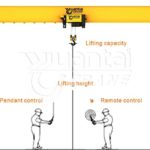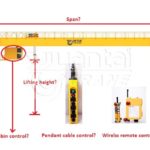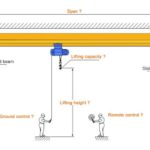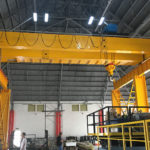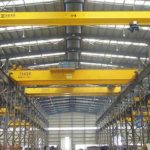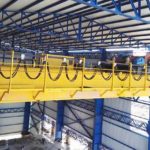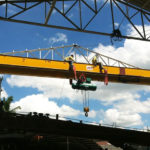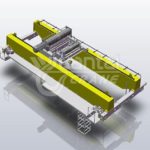Jib Crane Specifications | Understanding Jib Crane Requirements
Jib cranes are versatile lifting solutions designed to efficiently handle materials within a defined workspace. Understanding jib crane specifications is essential for selecting the right equipment that meets your specific lifting requirements.

- Capacity:
Rated Capacity: The maximum load weight a jib crane is designed to handle under normal operating conditions. - Jib Arm Length:
The horizontal distance from the central pivot point (mast) to the tip of the jib arm. Determines the coverage area and reach of the jib crane within the workspace. - Lifting Height:
Standard Lifting Height: The maximum vertical distance the crane can lift a load. - Rotation:
Rotation Angle: The ability of the jib crane to rotate horizontally. - Control System:
Pendant Control: A handheld control device for manually operating the crane. Some models offer wireless Remote Control for enhanced flexibility. - Environment:
Indoor/Outdoor Use: Specifies whether the jib crane is suitable for indoor, outdoor, or both environments.
Weatherproofing: Some models may include features to withstand outdoor conditions.
If you want to inquire about a jib crane from us, please provide at least the parameter information of the jib crane. After receiving your inquiry, we will provide you with a free quotation as soon as possible:
- lifting capacity:____ ton
- lifting height:____ m
- span: ____m
- voltage: ____V ____HZ ____Phase(for example: 380V-50Hz-3Phase)
Jib Crane Uses | Jib Crane Applications
- Workshops and Warehouses:
Ideal for lifting and moving materials within a confined workspace. - Loading Docks:
Efficiently loads and unloads materials from trucks and trailers. - Assembly Lines:
Facilitates the assembly process by providing precise material placement. - Machine Shops:
Supports machining operations by handling heavy components. - Maintenance Operations:
Aids in the maintenance of machinery and equipment. - Outdoor Construction Sites:
Wall-mounted jib cranes are suitable for construction projects with limited space. - Material Handling in Restricted Areas:
Navigates and lifts load in areas where traditional cranes may not be feasible.
Several Popular Jib Crane Specifications
Jib cranes generally have four design types according to different application scenarios. The following are the basic parameters of the four best-selling jib cranes.
- Wall Travelling Jib Crane
- Lifting Capacity: 0.5~16t
- Lifting Height: 3~10m
- Working Class: A3
- Ambient Temperature: -20~40℃
- Pillar Jib Crane
- Lifting Capacity: 1~10t
- Lifting Height: 1~12m
- Working Class: A3, A4
- Ambient Temperature: -20~40℃
Portable Jib Crane
Lifting Capacity: 0.25~2t
Lifting Height: 1~3m
Working Class: A3
Ambient Temperature: -20~40℃
Wall Mounted Jib Crane
Lifting Capacity: 0.25~10t
Lifting Height: 3~10m
Working Class: A3
Ambient Temperature: -20~40℃
Jib Crane Dimensions | Jib Crane Details
- Jib Arm Length:
Definition: The horizontal distance from the central pivot point (mast) to the tip of the jib arm.
Importance: Determines the coverage area and reach of the jib crane within the workspace. - Lifting Height:
Standard Lifting Height: The maximum vertical distance the crane can lift a load.
Adjustable Lifting Height: Some jib cranes allow customization of lifting heights to accommodate specific material handling needs. - Rotation Angle:
Definition: The range of horizontal rotation, typically measured in degrees (e.g., 180, 270, or 360 degrees).
Significance: Affects the crane’s ability to position loads precisely within the workspace. - Control System:
Pendant Control: A handheld control device for manually operating the crane.
Optional Remote Control: Some models offer wireless remote control for enhanced flexibility.
Importance: Influences the ease of operation and precision in material handling tasks. - Mounting Options:
Column Mounted: Freestanding on a vertical column.
Wall Mounted: Attached to a building or structure.
Importance: Determines the installation configuration based on available space and structural considerations. - Clearance Heights:
Definition: The minimum required vertical space above the load for safe lifting and movement.
Importance: Prevents collisions with overhead obstacles and ensures safe operations.
Hot Selling Jib Cranes | 2 Ton Jib Crane for Sale
- Crane Type: Portable Jib Crane
- Lifting Capacity: 2t
- Lifting Height: 1~3m
- Working Class: A3
- Ambient Temperature: -20~40℃

Jib Crane Standards | Jib Crane Design Standards
- ISO 231-1:2015 – Cranes – Classification – Part 1: General:
This International Organization for Standardization (ISO) standard provides general classifications and terms for cranes, including jib cranes. - FEM 1.001 – General Principles:
Issued by the European Materials Handling Federation (FEM), this document outlines general principles for the design of lifting equipment, including cranes. It guides safety factors, loadings, and structural design. - EN 13001 – Cranes – General Design:
This European standard provides general principles and requirements for the design of cranes, including jib cranes. It covers aspects such as loadings, strength, stability, and safety. - ASME B30.11 – Monorails and Underhung Cranes:
Published by the American Society of Mechanical Engineers (ASME), this standard covers the construction, installation, operation, inspection, and maintenance of monorails and underhung cranes, including jib cranes.




